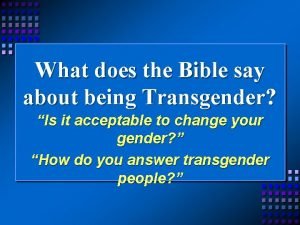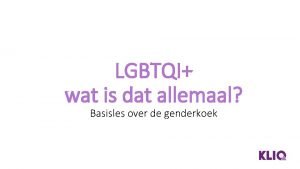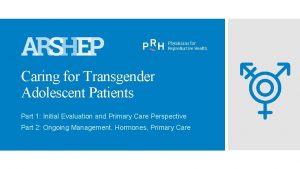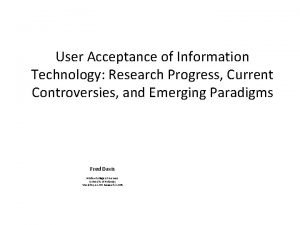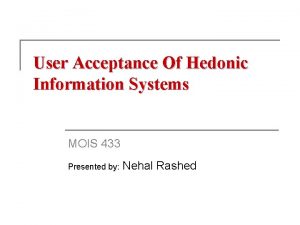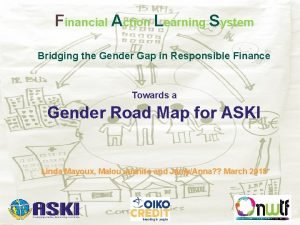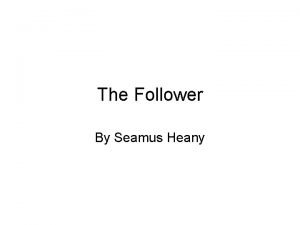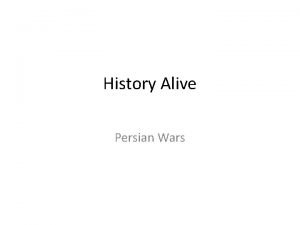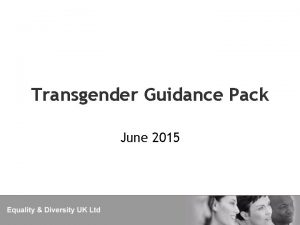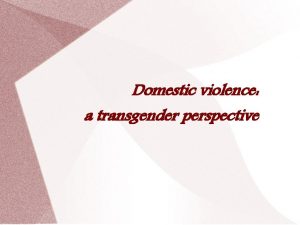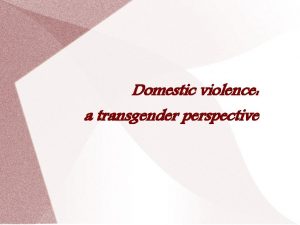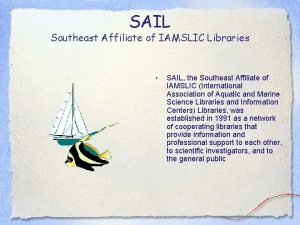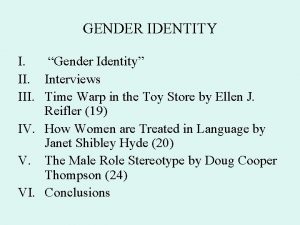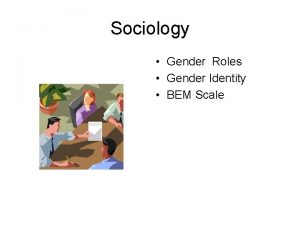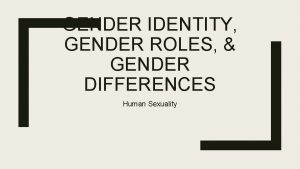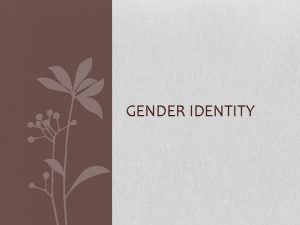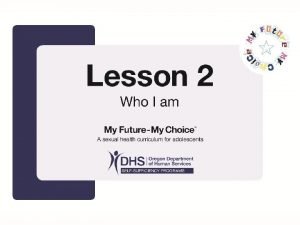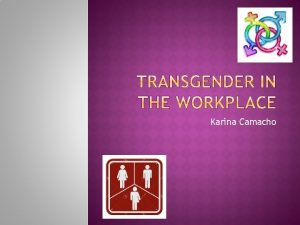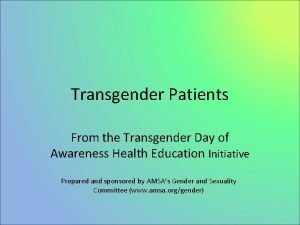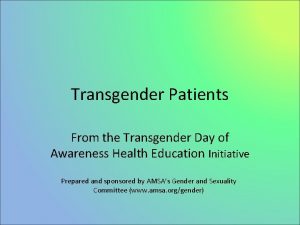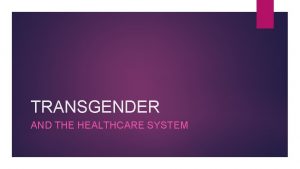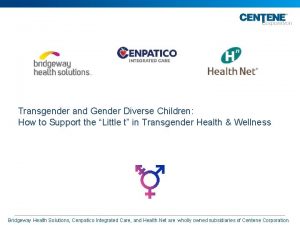SAIL Support Acceptance Information Learning Gender Identity Transgender


































- Slides: 34

SAIL – Support, Acceptance, Information, Learning Gender Identity & Transgender Awareness © SAIL 2014

What is Trans*? Terminology l Gender Identity: A person’s innate, deeply-felt psychological identification as a man, woman, or neither, which may or may not correspond to the person’s external body (phenotype) or assigned sex at birth (i. e. , the sex listed on the birth certificate). l Transgender: An umbrella term for people whose gender identity and/or gender expression differs from the sex assigned to them at birth. This term can include many gender identities such as: transsexual, transgender, crossdresser, drag performer, androgynous, genderqueer, gender variant or differently gendered people. l Gender variant: People whose gender identity and/or gender expression is different from traditional or stereotypical expectations of how a man or woman ‘should’ appear or behave. © SAIL 2013

What is Trans*? Terminology l Transition: A process through which some transgender people begin to live as the gender with which they identify, rather than the one assigned at birth. Transition might include social, physical or legal changes such as coming out to family, friends, co-workers and others; changing one's appearance; changing one’s name, pronoun and sex designation on legal documents (e. g. driving licence or passport); and medical intervention (e. g. through hormones or surgery). l Cisgender: A non-trans person l Gender Dysphoria: Gender dysphoria is a condition in which a person feels there is a mismatch between their sex assigned at birth and their gender identity - Many trans people see GID as an unwanted psychiatric diagnosis that is stigmatising and pathologising and does not represent their experience or does not acknowledge gender diversity © SAIL 2013

What is Trans*? Gender Dysphoria – Gender Variance l The young person experiences their assigned gender as incongruous with his or her own sense of gender identity. l It is with the onset of puberty that issues for Trans children often become more pronounced as gender roles become more relevant and their body morphs into something ‘alien’. l Gender dysphoria is not a mental illness but a physiological condition that is linked to genetic, hormonal and environmental factors that affect prenatal foetal developments (1) © SAIL 2014

What is Trans*? Gender Factors l X chromosome is associated with the development of secondary sex characteristics in females. Y chromosome genetic material is limited but does impact upon the endocrine system of the fetus. l The SRY and the ZFY chromosomes produce proteins that lead to hormones that masculinise the fetus. l The levels and timing of introduction can vary placing individuals on a gender spectrum. l Within the womb other factors can affect the rates and levels of chromosomes and hormones. (2) © SAIL 2014

What is Trans*? Gender Factors l Intersex Conditions/ Disorders of Sexual Development (DSD) l Typically, in humans there are 46 chromosomes arranged in pairs. In females, one pair is composed of two X chromosomes. In males, one pair is composed of an X and a Y chromosome. l In a study of eighteen individuals with 5α-RD, raised unambiguously as girls, seventeen rejected the female role and adopted a male gender role during or following puberty © SAIL 2014

What is Trans*? Brain Based Research l Research on post mortem brains of male-to-female transsexuals (Mt. Fs) and one female-to-male transsexual (Ft. M) has demonstrated that one of the sex-dimorphic brain nuclei, the central part of the bed nucleus of the stria terminalis, shows all characteristics of opposite—sex differentiation (3, 4) l 2009 research showed transwomens brain patterns shifted towards the female under certain stimuli (5) l 2008 study showed that Trans women demonstrated a pattern of activation away from the biological assigned gender…. With predominantly female-like mental features (6) l 2009 US study concluded that “brain anatomy plays a role in gender identity” (7) © SAIL 2014

What is Trans*? Brain Based Research l 2009 study concluded that “a decrease in testosterone levels in the brain during development might prevent complete masculinization of the brain in male to female transsexuals and thereby cause a more feminized brain and a female gender identity. ” (8) © SAIL 2014

Treatment & Practice Gender Variant Children l Less than 4% of T individuals understand they are Trans after 18 yrs l 80% realise they are T whilst attending primary school l 8 yrs old is the mean average T children become aware of their variance (9) Age at which gender variance is realised © SAIL 2014

Treatment & Practice Gender Variant Children “Trying to change a person’s gender identity and expression to become more congruent with the sex assigned at birth has been attempted in the past without success, particularly in the long term. Such treatment is no longer considered ethical” WPATH- World Professional Association for Transgender Health © SAIL 2014

© SAIL 2014

References 1. Reed B, Rhodes S, Schofield P, Wylie K. Gender Variance in the UK: Prevalence, Incidence, Growth & Geographic Distribution. GIRES 2009; 2. GIRES et al. (2006). Atypical Gender Development - A Review, International Journal of Transgenderism, 9(1) p 29 -44. 3. Zhou J, Hofman MA, Gooren LJ, Swaab DF. A sex difference in the human brain and its relation to transsexuality. Nature 1995; 378: 68– 70. 4. Kruijver FP, Zhou J, Pool C, Hofman MA, Gooren LJ, Swaab DF. Male-to-female transsexuals have female neuron numbers in a limbic nucleus. J Clin Endocrinol Metab 2000; 85: 2034– 41. 5. Gizewski, E. R. , Krause, E. , Schlamann, M. , Happich, F. , Ladd, M. E. , Forsting, M. , & Senf, W. (2009). Specific cerebral activation due to visual erotic stimuli in male-to-female transsexuals compared with male and female controls: An f. MRI study. Journal of Sexual Medicine, 6, 440– 448. 6. H. Berglund, P. Lindström, C. Dhejne-Helmy & I. Savic (2008). Male-to-Female Transsexuals Show Sex-Atypical Hypothalamus Activation When Smelling Odorous Steroids. Cerebral Cortex. © SAIL 2014

References 7. Luders, E. , Sanchez, F. J. , Toga, A. W. , Narr, K. L. , Hamilton, L. S. , & Vilain, E. (2009). Regional gray matter variation in male-to-female transsexualism. Neuroimage, 46, 904 -907. 8. Hare L, Bernard P, Sánchez FJ, Baird PN, Vilain E, Kennedy T, Harley VR (2009) Androgen receptor repeat length polymorphism associated with male-to-female transsexualism. Biol Psychiatry. 65(1): 93 -96 9. Kennedy N. (Revised 2012) Transgender Children: more than a theoretical challenge. © SAIL 2014

LGB T Gender Identity

© SAIL 2014

The Family Perspective Me You Us Them We





The Northern Ireland Perspective : Services Adult Service Adolescent Service K O I Gender Identity Clinic Knowing Our Identity

Research in N Ireland

Recommendation 8 The Department of Education Northern Ireland in conjunction with the Council for the Curriculum Examinations and Assessment should integrate information about gender identity, gender distress and transgender issues into Northern Ireland’s school curriculum. This process should involve consultation with relevant community and voluntary group Recommendation 9 The Department of Education Northern Ireland should, as a matter of urgency, produce comprehensive policy guidance for schools relating to young people who experience gender distress and/or identify as trans. This guidance should include information regarding school uniforms for trans pupils and anti-transphobic bullying protocols. The guidance should be produced in line with international best practice and through consultation with relevant stakeholders. It should be reviewed regularly to ensure guidance remains in line with current best practice. In addition, the emotional health and well-being needs of trans pupils should be incorporated into the Department of Education’s ‘Pupils’ Emotional Health and Wellbeing Programme. ’ Research into audit tools and existing good practice should be conducted to ensure that the needs of young trans people are met in a consistent and coherent way. l


Recommendation 10 l The Equality Commission should conduct a comprehensive review of the education inequalities faced by young trans people living in Northern Ireland. Recommendation 11 l The Education and Library Boards should, as a matter of urgency, recognise trans young people as a ‘priority group’ who face multiple inequalities; identify on-going work and actions that address these inequalities; and, propose actions to be built into an agreed inter-Board/Staff Commission Equality Action Plan, which includes performance indicators and anticipated outcomes. This should be done in consultation with relevant community and voluntary groups

Recommendation 12 l The Department of Education Northern Ireland should promote ‘Gay-Straight Alliances’ as a model of best practice for helping to reduce homophobic and transphobic prejudice and discrimination in school settings.


Little Rock Girl 1957: How a Photograph Changed the Fight for Integration Elizabeth Eckford Nine African American students made history when they defied a governor and integrated an Arkansas high school in 1957. It was the photo of one of the nine trying to enter the school a young girl being taunted, harassed and threatened by an angry mob that grabbed the worlds attention and kept its disapproving gaze on Little Rock, Arkansas.

Cisgender Privelege

1. There's nothing wrong with our children. 2. Younger kids generally handle the idea of transgender children well. . . 3. And "adults" are the worst. 4. Access to care experienced with transgender youth is spotty, but nearly universally supportive. 5. Schools are getting it right (most of the time). 6. Having a transgender child isn't always the hardest part about having a transgender child. . . 7. Trans-feminine children get the worst of it. 8. Don't judge us when you haven't walked a mile in our shoes.




SAIL – Support, Acceptance, Information, Learning Gender Identity & Transgender Awareness © SAIL 2014
 Strategic gender needs and practical gender needs
Strategic gender needs and practical gender needs Development of gender roles
Development of gender roles Sexual orientation gender identity
Sexual orientation gender identity Gender identity
Gender identity Gender identity tagalog
Gender identity tagalog What does the bible say about transgender
What does the bible say about transgender Gnc knoxville tn
Gnc knoxville tn Bisexual genogram symbol
Bisexual genogram symbol Transgender umbrella
Transgender umbrella Cisgender
Cisgender Ihsa transgender policy
Ihsa transgender policy Before mt everest was discovered riddle
Before mt everest was discovered riddle Transgender
Transgender De genderkoek
De genderkoek What is transgender
What is transgender Transgender
Transgender User acceptance of information technology
User acceptance of information technology User acceptance of hedonic information systems
User acceptance of hedonic information systems Identity map activity
Identity map activity Cuadro comparativo entre e-learning b-learning y m-learning
Cuadro comparativo entre e-learning b-learning y m-learning Vpey
Vpey His shoulders globed
His shoulders globed Solid sail
Solid sail When did christopher columbus sail the ocean blue
When did christopher columbus sail the ocean blue Why did the athenians sail to nearby islands in panic
Why did the athenians sail to nearby islands in panic History of henry hudson
History of henry hudson Themes in follower
Themes in follower Bartolomeu dias
Bartolomeu dias Sail wagon epoch
Sail wagon epoch How a sail works
How a sail works Elastic sail ties
Elastic sail ties John cabot route of exploration
John cabot route of exploration When did christopher columbus sail
When did christopher columbus sail Why did francis west sail up the chesapeake
Why did francis west sail up the chesapeake Mississippi river
Mississippi river





